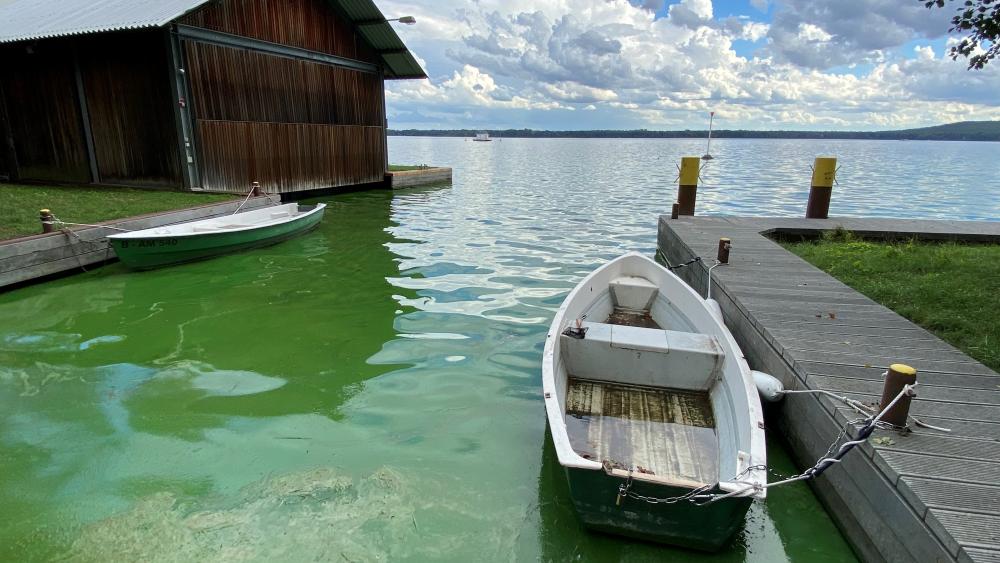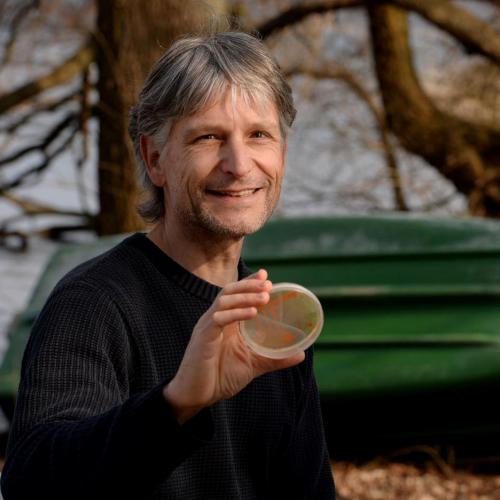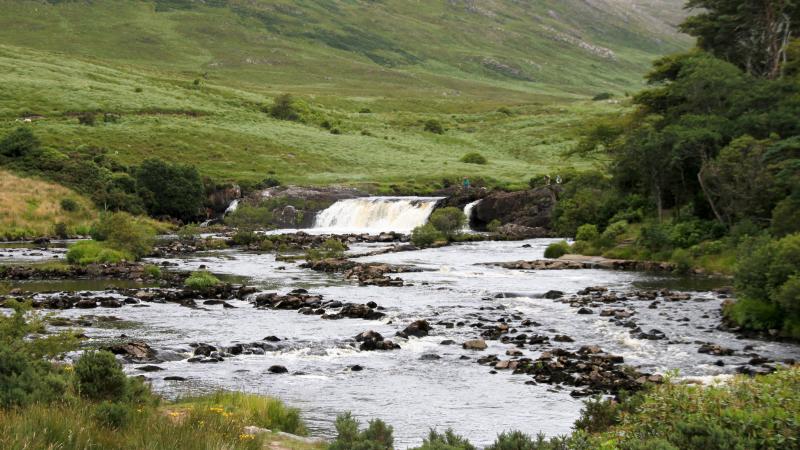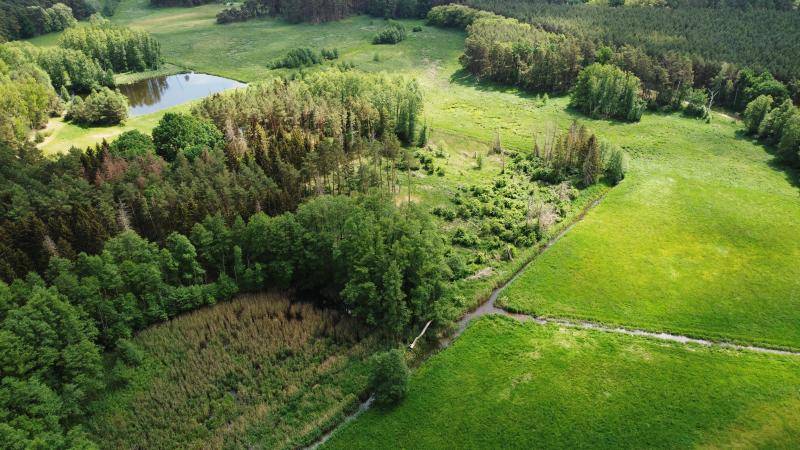
The lake turns green. Mass developments of cyanobacteria can be easily recognized by the color of the water. | Photo: Luc De Meester
Mass developments of cyanobacteria not only look unattractive, they also impair water quality and thus the use of water bodies as sources of drinking water and for recreational activities. They can affect other living organisms in the water by absorbing light at the surface and consuming oxygen for decomposition processes at depth as they sink. Some species can also produce toxins.
Favorable conditions for the development of blue-green algae blooms: high temperatures, lots of light, plenty of nutrients
But managing blue-green algae blooms is difficult. There are several thousand species of cyanobacteria that can vary greatly in appearance, characteristics, and requirements. "Knowing which environmental factors and interactions reduce blue-green algae blooms in natural ecosystems is crucial for a possible reductions of algae blooms in the future", said Dr Stella Berger.
Cyanobacteria blooms often occur when temperatures and light levels are high and the water is polluted with nutrients (phosphorus and nitrogen). These factors certainly play a role in the decline of algal blooms. But there are many other physical, chemical, and biological factors.
.jpg)
Anabaena solitaria | Photo: Maren Lentz
And this is how they can subside
1. Mixing and heavy rainfall can end algal blooms
For example, water mixing can end algal blooms. The effect of water mixing depends on whether the algae are cyanobacteria, which tend to accumulate on the surface. Compared to species that are distributed throughout the water column, floating species can be easily dispersed over long distances by wind – mass accumulations dissipate.
Rain can stimulate cyanobacterial blooms by adding more nutrients to the water, or slow them down by mixing the water more thoroughly. Some free-living cyanobacteria are sensitive to storm-induced turbulence, while others are adapted to it. When the gas vesicles of some floating cyanobacteria collapse under the hydrostatic pressure of heavy rain, the algal bloom is also terminated.
2. Chemical substances from other organisms as a weapon against cyanobacteria
Even the smallest organisms in water have the ability to limit the dominance of other organisms by releasing chemical substances. Allelochemicals that influence a cyanobacterial bloom are produced by various organisms such as aquatic plants, heterotrophic bacteria, fungi, other phytoplankton as well as terrestrial plants. For example, some aquatic fungal species produce oxygen radicals that can damage the cell membrane and destroy the cells of various bloom-forming cyanobacteria species.
3. When cyanobacteria become "sick"
Parasites, viruses and bacteria can also attack cyanobacteria directly and limit their growth. One example is cyanobacterial phages, virus-like particles. They are thought to attack a wide range of host species and can stop algal blooms within a few days. A co-culture experiment with natural virus populations and the cyanobacterial species Microcystis showed a clear correlation between phage density and cyanobacterial lysis, resulting in a 95 per cent reduction in the Microcystis population within six days.
"Diverse biotic communities in freshwater ecoystems therefore make a significant contribution to the balance of organism groups and are definitely helpful in keeping algal blooms under control", said Dr Danny Ionescu.
4. Fate: being eaten
Although some cyanobacteria are not very nutritious and can produce toxins, they are still eaten by larger organisms. In particular, zooplankton literally graze on the blooms. Daphnia, for example, can adapt to the toxins of cyanobacteria in the same ecosystem and use them as a food source. Mussels can also act as filter feeders to reduce algal blooms - including invasive triangular mussels such as the quagga mussel in Europe and North America. Several studies have shown that the abundance of cyanobacteria can be reduced by up to 58 per cent following the invasion of quagga mussels. Some fish species are also predators of cyanobacteria.
5. Competition for light and food
Mixotrophic algae, i.e. algae that photosynthesise for energy as well as eating cells to obtain carbon compounds for their growth, can also contribute to the decline of cyanobacterial blooms. They compete with cyanobacteria for abiotic resources such as light and nutrients, but also reduce the density of cyanobacteria, especially smaller species, by feeding on them.
Management of blue-green algae blooms: complex, success uncertain
Many of the above mechanisms can be used in water management to reduce algal blooms. Some studies have shown that artificial mixing can be an effective strategy in deeper lakes. However, in shallow, unstratified waters, it can be counterproductive because it releases phosphorus from the sediments, which promotes the growth of cyanobacteria.
Another physical method is flushing, which reduces the residence time of the water and has been successfully used in some lakes. However, it is unsuitable in times of water scarcity.
There are also chemical methods, such as copper sulphate and hydrogen peroxide. "However, these should be avoided because of unintended or unexpected negative effects on other organisms in the water", said Professor Hans-Peter Grossart. Biological control by predators is also a method with an often uncertain outcome. "It is not possible to control which species of phytoplankton are filtered out and eaten by zooplankton or mussels."
Not a standard procedure: Prevention is better than treatment
The right method depends on the ecosystem type, the species of cyanobacteria and the environmental conditions. A study from last year compared the efficiency, duration and costs of different approaches to controlling cyanobacterial blooms: the same method can have a 30 % difference in efficiency, but different approaches to reducing blooms, alone or in combination, can eliminate up to 100 % of the algae bloom biomass. "Finally, when considering and implementing any type of control measure, it is crucial to integrate ecological background knowledge into the technical design. Failures are often due to underestimating the complexity of the issue, not taking into account the characteristics of the cyanobacteria causing the problem or the type of water body", said Dr Mina Bizic. As so often, prevention – reducing nutrient inputs, supporting natural processes and promoting biodiversity – is the method of choice.
Increased or decreased algal blooms due to climate change?
Climate change fosters the growth of cyanobacteria through higher temperatures, more stable and prolonged thermal stratification, nutrient loading and changes in food web dynamics. However, studies on that topic have shown contradictory results: some have found an increase in cyanobacteria, others have not. This is because not only growth processes can be stimulated, but also loss processes. For example, higher temperatures sometimes lead to higher infection rates, which compensate for the spread of cyanobacteria.
"In fact, we need to pay more attention not only to growth processes but also to loss processes in order to understand the net effect of climate change on the development of algal blooms", concluded Dr Stella Berger. One way to monitor the development and decline of cyanobacterial blooms is through remote sensing. "Cameras on satellites or drones help to estimate the chlorophyll-a content of water bodies and thus determine the spatial and temporal distribution of algal biomass“, added Dr Igor Ogashawara.










